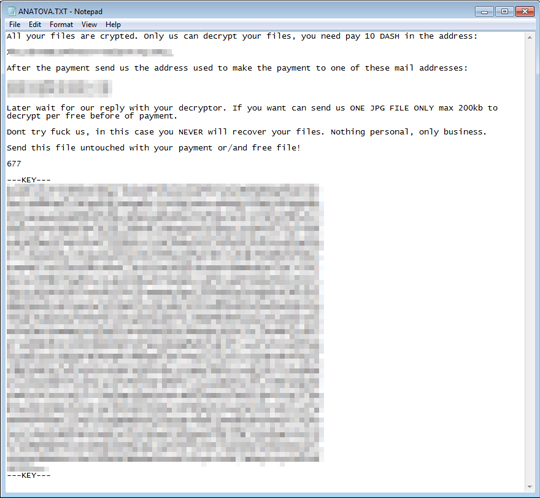Ransom.Win64.ANATOVA.THOAAGAI
Trojan-Ransom.Win64.Anatova.f (Kaspersky), Ransom:Win32/Anatova (Microsoft), W64/Anatova.18AA!tr.ransom (Fortinet)
Windows


Threat Type: Ransomware
Destructiveness: No
Encrypted: Yes
In the wild: Yes
OVERVIEW
Downloaded from the Internet
This Ransomware arrives on a system as a file dropped by other malware or as a file downloaded unknowingly by users when visiting malicious sites.
It encrypts files found in specific folders. It drops files as ransom note.
TECHNICAL DETAILS
730,865 bytes
EXE
No
Displays message/message boxes, Encrypts files
Arrival Details
This Ransomware arrives on a system as a file dropped by other malware or as a file downloaded unknowingly by users when visiting malicious sites.
Installation
This Ransomware adds the following mutexes to ensure that only one of its copies runs at any one time:
- use7wtXnWAl3XoSpB3prlZxLs83KWS8UKK609T5hPfIch1Wueu
Process Termination
This Ransomware terminates the following processes if found running in the affected system's memory:
- infopath.exe
- winword.exe
- excel.exe
- outlook.exe
- msaccess.exe
- mspub.exe
- onenote.exe
- powerpnt.exe
- steam.exe
- thebat.exe
- thebat64.exe
- thunderbird.exe
- visio.exe
- wordpad.exe
- msftesql.exe
- sqlagent.exe
- sqlbrowser.exe
- sqlwriter.exe
- oracle.exe
- ocssd.exe
- dbsnmp.exe
- synctime.exe
- agntsvc.exe
- isqlplussvc.exe
- xfssvccon.exe
- sqlservr.exe
- mydesktopservice.exe
- ocautoupds.exe
- encsvc.exe
- firefoxconfig.exe
- tbirdconfig.exe
- mydesktopqos.exe
- ocomm.exe
- mysqld.exe
- mysqld-nt.exe
- mysqld-opt.exe
- dbeng50.exe
- sqbcoreservice.exe
Other Details
This Ransomware does the following:
- After encrypting all the files it deletes shadow copies by executing the following command ten (10) times:
- cmd.exe /c vssadmin delete shadows /all /quiet
- Then delete itself by executing the following commands:
- cmd.exe /c timeout -c 9 & del {malware filename}.exe /f /q
- It avoids encrypting files with the following file extensions:
- .ani
- .bat
- .cab
- .cmd
- .cpl
- .cur
- .diagcab
- .diagpkg
- .dll
- .drv
- .exe
- .hlp
- .icl
- .icns
- .ico
- .ics
- .idx
- .key
- .ldf
- .lnk
- .mod
- .mpa
- .msc
- .msp
- .msstyles
- .msu
- .ocx
- .prf
- .rom
- .rtp
- .scr
- .shs
- .spl
- .sys
- .theme
- .themepack
- .ocx
Ransomware Routine
This Ransomware encrypts files found in the following folders:
- {Fixed Drive} ← hard disk drive and flash drive
- {Network Drive}
It avoids encrypting files with the following strings in their file name:
- bootinit
- ANATOVA.TXT
- ntuser.dat.lo
- ntuser.dat
- ntldr
- NTDETECT.COM
- iconcache.db
- bootsect.bak
- Bootfont.bin
- autorun.inf
- swapfile.sys
- pagefile.sys
- hiberfil.sys
- thumbs.db
- boot.ini
- desktop.ini
It avoids encrypting files with the following strings in their file path:
- \Program Files (x86)
- \Windows
- \ProgramData
- \Tor Browser
- \Local Settings
- \IETldCache
- \Boot
- \All Users
- \Program Files
It drops the following file(s) as ransom note:
- {encrypted files directory}\ANATOVA.TXT

SOLUTION
9.850
14.756.04
17 Jan 2019
14.757.00
18 Jan 2019
Step 1
Before doing any scans, Windows XP, Windows Vista, and Windows 7 users must disable System Restore to allow full scanning of their computers.
Step 2
Note that not all files, folders, and registry keys and entries are installed on your computer during this malware's/spyware's/grayware's execution. This may be due to incomplete installation or other operating system conditions. If you do not find the same files/folders/registry information, please proceed to the next step.
Step 3
Identify and terminate files detected as Ransom.Win64.ANATOVA.THOAAGAI
- Windows Task Manager may not display all running processes. In this case, please use a third-party process viewer, preferably Process Explorer, to terminate the malware/grayware/spyware file. You may download the said tool here.
- If the detected file is displayed in either Windows Task Manager or Process Explorer but you cannot delete it, restart your computer in safe mode. To do this, refer to this link for the complete steps.
- If the detected file is not displayed in either Windows Task Manager or Process Explorer, continue doing the next steps.
Step 4
Search and delete these files
- {encrypted files directory}\ANATOVA.TXT
Step 5
Scan your computer with your Trend Micro product to delete files detected as Ransom.Win64.ANATOVA.THOAAGAI. If the detected files have already been cleaned, deleted, or quarantined by your Trend Micro product, no further step is required. You may opt to simply delete the quarantined files. Please check the following Trend Micro Support pages for more information:
Step 6
Restore encrypted files from backup.
Did this description help? Tell us how we did.

